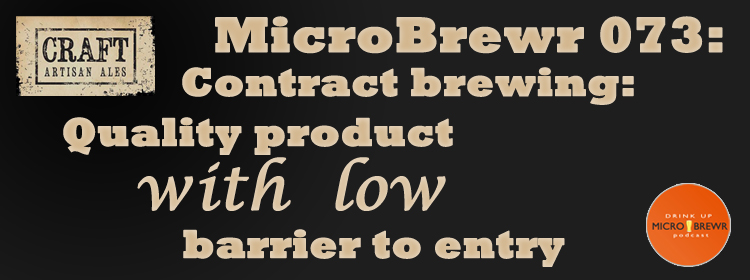MicroBrewr 073: Contract brewing: quality product with low barrier to entry
Podcast: Play in new window | Download | Embed
Subscribe: RSS
David Olsen dives into things all the way. He decided that he wanted to homebrew, so he read about 15 books and took some short classes at UC Davis. Within 6 months he was winning awards at homebrewing competitions. He started Craft Artisan Ales, in Pacific Grove, California, with contract brewing because it was an easier barrier to entry.
“Even to get like a 7-BBL system going, you’re going to need at least a half-million dollars,” estimates David. “Then you have the labor, the insurance, the overhead, the space, the lease, all those other factors that go into it.
“So to be able to go to a facility that can take your recipes and create a quality end product [in exchange] for part of the margin, is definitely an appealing way to get into the craft beer industry.”
Other contract breweries—or breweries that got their start as a contract brewery—on MicroBrewr Podcast:
David has some recommendations to nail down your beer styles and recipes:
- Spend a lot of time working on one single beer, then develop other recipes from there.
- Take some brewing classes, even weekend classes or 2-week classes.
- Be super careful about sanitation and temperature control.
You’ll need to have accounts confirmed to buy your beer when it’s ready from the brewer. Here’s what David did:
- He pushed the local angle in his products by using local names and themes.
- Friends who owned restaurants agreed to carry his beer on tap.
- The owner of the homebrew store helped make other connections.
- He put samples in a cooler pack and walked into stores to talk to the manager.
- He provided a sample, sales sheet, and business card everywhere he went.
Contract brewing is a much easier way to enter the craft beer market. The cost is a tiny fraction of what it costs to open your brewery. The time that you would have spent brewing can be spent marketing, delivering product, nurturing relationships, and all the other things required when you own your own brewery.
Brewery specs:
Kettle size: 25-BBL contract facility.
Size and quantity of fermentation tanks: 25-, 50-, and 100-BBL tanks available.
Size and quantity of bright tanks: Same.
Annual brewing capacity/last year’s production: Capacity is 15-20K BBL for the contract facility. Last year Craft Artisan Ales produced about 1,000 BBL.
Square footage: 80,000 sq. ft. at the contract facility.
Years in operation: 18 months (opened February 2014).
“I don’t have an exit plan because I want it to be a career. All I have are expansion plans.” [Tweet This]
Listener question:
From The Beer Sommelier: What is your exit plan?
Book recommendation:
- Pizza: More than 60 Recipes for Delicious Homemade Pizza by Diane Morgan and Tony Gemignani.
- The Brewers Association’s Guide to Starting Your Own Brewery by Ray Daniels.
Check out the entire list of recommended books, click here.
An upcoming beer style:
Sour beers
Other resources:
- Beer Exam School, free study resources for Cicerone® Certified Beer Server.
- Communicating Craft, marketing & advertising resources from Brewers Association.
- Tony Gemignani’s International School of Pizza, San Francisco.
- History of the Salinas Brewery, Brewery Gems, breweriana and brewery histories.
You can reach David Olsen and Craft Artisan Ales at:
Sponsors:
Support MicroBrewr
Help keep MicroBrewr on the air. CLICK HERE for ways you can help.





